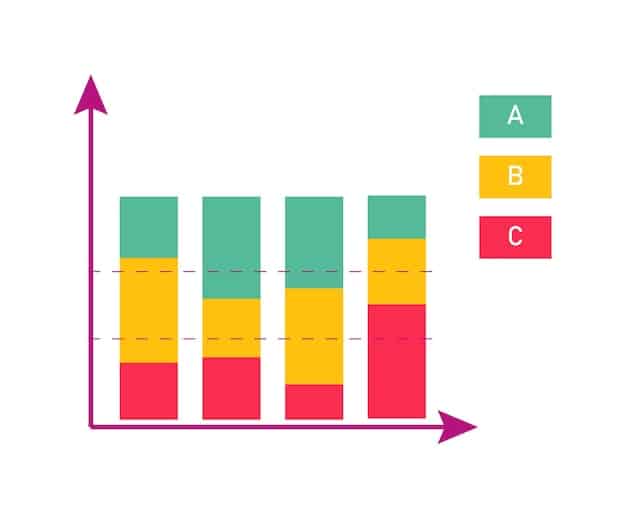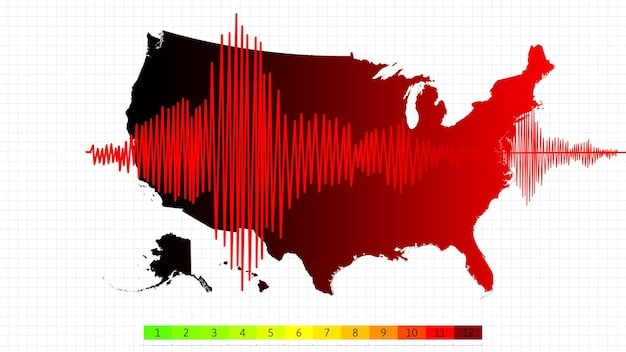National Assessment Results: See US State Math and Reading Rankings

The National Assessment of Educational Progress (NAEP) results reveal how US states rank in math and reading, highlighting strengths and areas needing improvement in education.
Discover how your state measures up in math and reading based on the latest National Assessment Results Released: Where Does Your State Rank in Math and Reading?. Understand your state’s educational standing and what it means for students.
Understanding the National Assessment of Educational Progress (NAEP)
The National Assessment of Educational Progress (NAEP), often referred to as “The Nation’s Report Card,” is a standardized assessment that measures student achievement across the United States. It provides valuable insights into how well students in different states and demographic groups are performing in key subjects like math and reading.
This assessment is crucial for policymakers, educators, and parents to understand the current state of education. By comparing performance across states, NAEP helps identify best practices and areas where additional support is needed.
Purpose of the NAEP
The NAEP serves several important purposes:
- Measuring Achievement: It provides a snapshot of what students know and can do in various subjects.
- Tracking Progress: It allows for the tracking of educational progress over time, identifying trends and patterns in student performance.
- Comparing States: It enables comparisons of student achievement across different states, highlighting regional variations in education.
Subjects Covered
The NAEP assesses students in a variety of subjects, including mathematics, reading, science, and writing. These assessments are conducted periodically, with a focus on grades 4, 8, and 12.

The NAEP results are an essential tool for evaluating the effectiveness of educational policies and practices at the national and state levels. Stay tuned as we delve deeper into the latest findings and analyze where each state stands.
Key Findings from the Latest NAEP Results
The most recent NAEP results offer a comprehensive overview of student performance in math and reading. Several key findings have emerged, shedding light on both successes and challenges in the American education system.
These findings provide valuable data for understanding the impact of various factors on student achievement, including curriculum changes, teacher training, and resource allocation.
Overall Performance
The data reveals trends in student performance across the nation:
- Math Scores: Some states showed improvements in math scores, particularly in elementary grades, while others experienced declines.
- Reading Scores: Reading scores generally remained stable, with some states showing slight improvements or declines.
- Achievement Gaps: Significant achievement gaps persist between different demographic groups, highlighting the need for targeted interventions.
Factors Influencing Performance
Several factors have been identified as influencing student performance:
- Funding Levels: States with higher levels of education funding tend to see better student outcomes.
- Teacher Quality: Access to highly qualified teachers is a critical factor in student achievement.
- Early Childhood Education: Early childhood education programs have a positive impact on long-term academic success.
By examining these findings, educators and policymakers can gain a better understanding of the levers that can be used to improve student outcomes and narrow achievement gaps across the nation.
State-by-State Breakdown: Math Rankings
A detailed look at the NAEP math rankings reveals significant variations in performance across different states. Understanding these rankings can help identify states that are leading the way in math education and those that need additional support.
This breakdown offers a clear picture of how each state is performing in math, highlighting the strengths and weaknesses of their educational systems.
Top Performing States
The following states consistently rank high in math achievement:
- Massachusetts: Known for its rigorous math curriculum and highly qualified teachers.
- New Jersey: Has invested heavily in STEM education and teacher professional development.
- Minnesota: Emphasizes problem-solving and critical thinking in its math programs.
States Needing Improvement
Some states face challenges in math education and need to focus on improving student outcomes:
- Mississippi: Struggles with funding and teacher shortages, impacting math achievement.
- New Mexico: Needs to address achievement gaps and improve access to quality math education.
- Louisiana: Faces challenges related to poverty and limited resources for education.

By analyzing these rankings, states can learn from each other and implement strategies to enhance math education for all students. Each state’s unique challenges and opportunities should be considered when developing improvement plans.
State-by-State Breakdown: Reading Rankings
Similar to math, the NAEP reading rankings provide insights into how students are performing in reading across different states. These rankings are crucial for understanding the strengths and weaknesses of reading education in each state.
By examining the reading rankings, states can identify areas where they excel and areas where additional focus is needed to improve student literacy.
Top Performing States
The following states consistently demonstrate high reading achievement:
- Vermont: Emphasizes early literacy and provides strong support for struggling readers.
- New Hampshire: Focuses on developing strong reading comprehension skills from an early age.
- Maine: Implements evidence-based reading programs and provides ongoing professional development for teachers.
Strategies for Success
Top-performing states often share common traits that contribute to their success:
- Comprehensive Literacy Programs: Implementing comprehensive literacy programs that address all aspects of reading instruction.
- Early Intervention: Providing early intervention for students who are struggling with reading.
- Parental Involvement: Engaging parents in their children’s reading development.
By adopting these strategies, states can improve reading outcomes for all students and ensure that they are well-prepared for future academic success.
Impact of Socioeconomic Factors
Socioeconomic factors play a significant role in student achievement, often creating disparities in educational outcomes across different communities and states. Understanding these factors is crucial for addressing achievement gaps and promoting equity in education.
Socioeconomic factors can influence access to resources, quality of instruction, and overall learning environment, impacting student performance in math and reading.
Poverty and Education
Poverty has a profound impact on student achievement:
- Resource Scarcity: Schools in low-income communities often lack the resources needed to provide a high-quality education.
- Health and Nutrition: Poor health and nutrition can affect students’ ability to concentrate and learn.
- Home Environment: Students from low-income families may face challenges such as unstable housing and limited access to educational materials.
Addressing the Challenges
Addressing socioeconomic disparities in education requires a multi-faceted approach:
- Increased Funding: Providing additional funding to schools in low-income communities to address resource gaps.
- Community Support: Implementing programs that support families and address the social determinants of health.
- Targeted Interventions: Providing targeted interventions for students who are struggling due to socioeconomic factors.
By understanding and addressing the impact of socioeconomic factors, states can create a more equitable education system and improve outcomes for all students, regardless of their background.
Strategies for Improvement
Improving student achievement in math and reading requires a comprehensive and strategic approach that addresses various aspects of the education system. By implementing evidence-based strategies and best practices, states can enhance learning outcomes for all students.
These strategies should focus on enhancing teacher quality, improving curriculum, and providing additional support for struggling learners.
Enhancing Teacher Quality
Investing in teacher quality is essential for improving student outcomes:
- Professional Development: Providing ongoing professional development for teachers to enhance their skills and knowledge.
- Mentoring Programs: Implementing mentoring programs that pair experienced teachers with new educators to provide support and guidance.
- Recruitment and Retention: Developing strategies to recruit and retain high-quality teachers, particularly in high-need areas.
Improving Curriculum and Instruction
Curriculum and instruction should be aligned with best practices and tailored to meet the needs of all students:
- Evidence-Based Practices: Implementing evidence-based instructional practices that have been shown to be effective.
- Differentiated Instruction: Providing differentiated instruction to meet the diverse learning needs of students.
- Technology Integration: Integrating technology into the classroom to enhance learning and engagement.
By prioritizing these strategies, states can create a more effective and equitable education system that prepares all students for success in college, careers, and life.
| Key Point | Brief Description |
|---|---|
| 📊 NAEP Overview | The NAEP assesses student performance in math and reading nationwide. |
| 🥇 Top States | Massachusetts, New Jersey, and Vermont are top performers in math and reading. |
| 🏫 Challenges | States like Mississippi and New Mexico face challenges in education funding and teacher shortages. |
| 💡 Improvement | Strategies include enhancing teacher quality and improving curriculum. |
Frequently Asked Questions (FAQ)
▼
The National Assessment of Educational Progress (NAEP) is a standardized assessment that measures student achievement in various subjects across the United States, often called “The Nation’s Report Card.”
▼
The NAEP typically assesses students in grades 4, 8, and 12 in subjects such as mathematics, reading, science, and writing, providing insights into student performance at different educational levels.
▼
NAEP scores provide valuable data for policymakers, educators, and parents to understand student achievement trends, identify areas for improvement, and make informed decisions about educational policies.
▼
Factors influencing NAEP scores include funding levels, teacher qualifications, early childhood education programs, socioeconomic conditions, and curriculum quality, highlighting the complexity of educational outcomes.
▼
States can improve NAEP scores by enhancing teacher quality, implementing evidence-based instructional practices, providing targeted support for struggling learners, and addressing socioeconomic disparities in education.
Conclusion
The National Assessment Results Released: Where Does Your State Rank in Math and Reading? offers a critical view into the educational landscape of the United States. By understanding these rankings and the factors that influence them, states can work towards improving their educational systems and ensuring that all students have the opportunity to succeed. Continuous monitoring, strategic planning, and collaborative efforts are essential for creating an equitable and effective education system nationwide.





